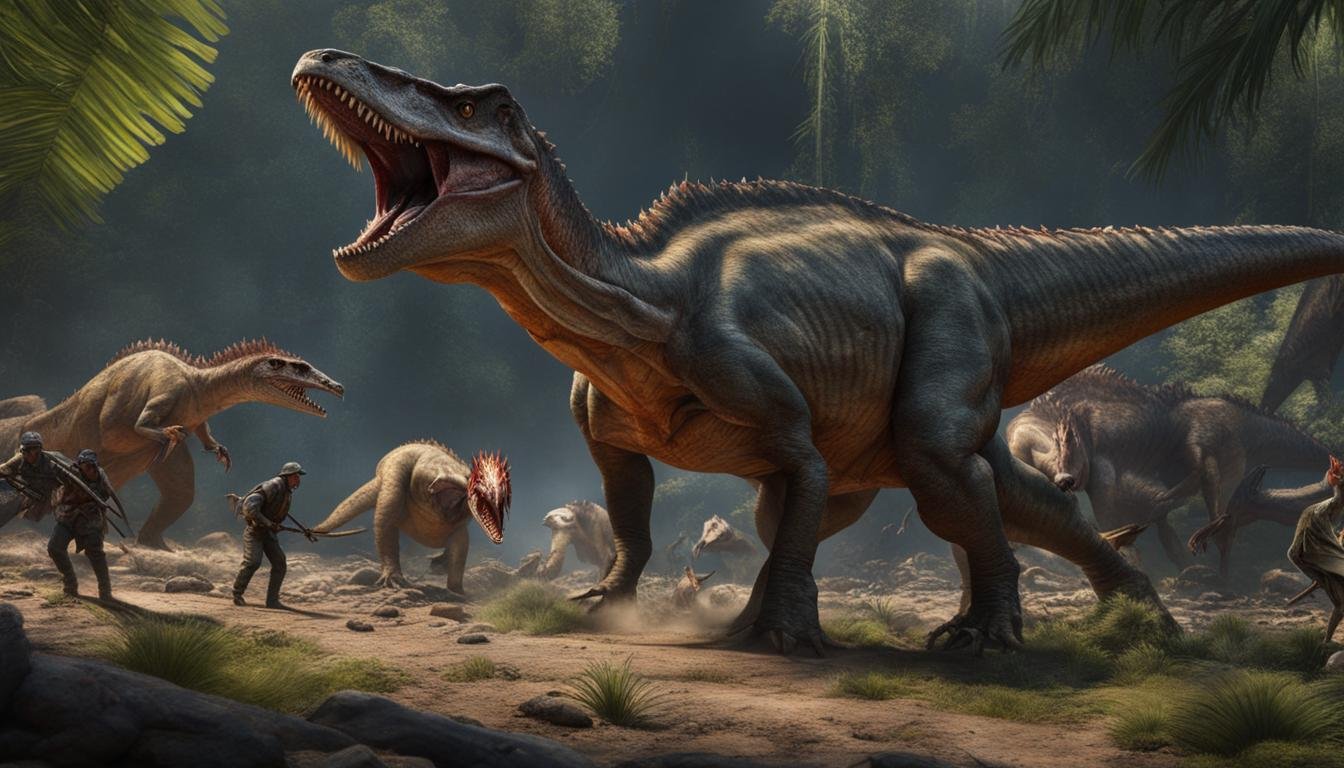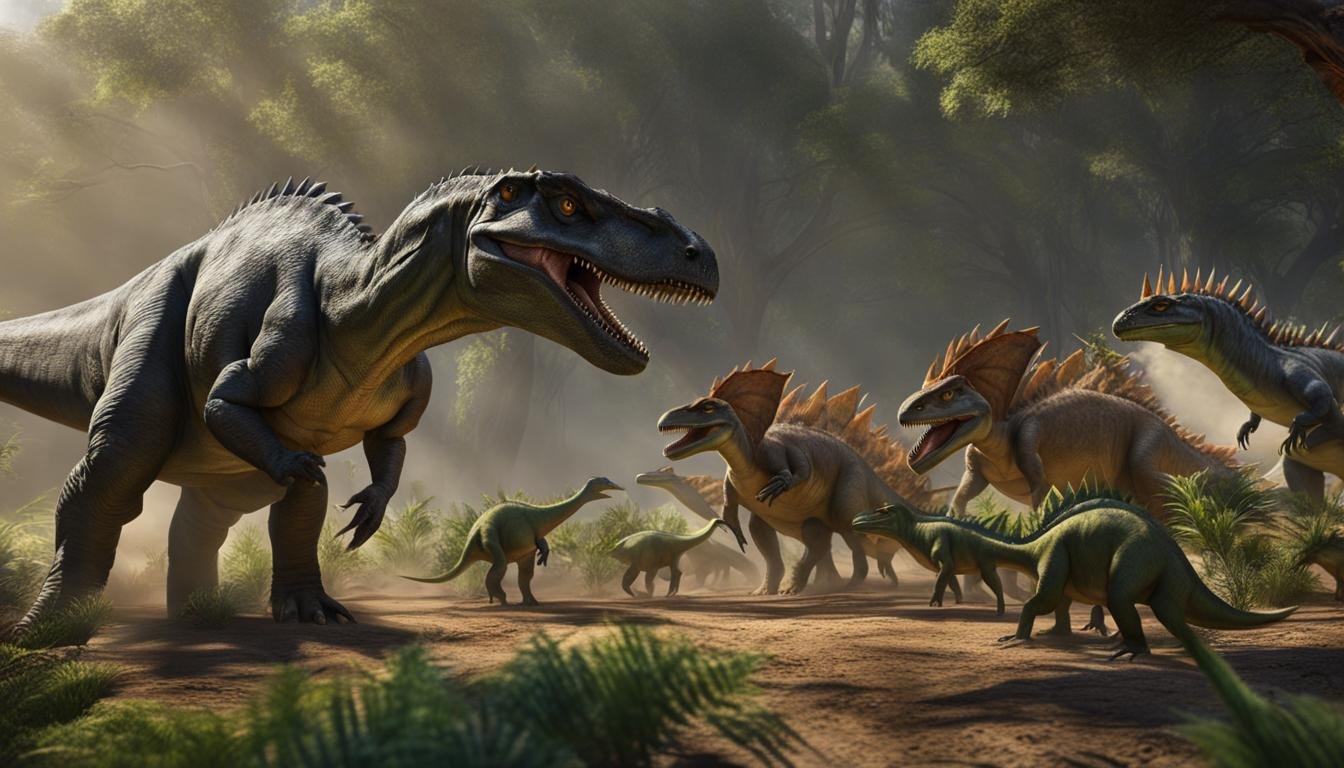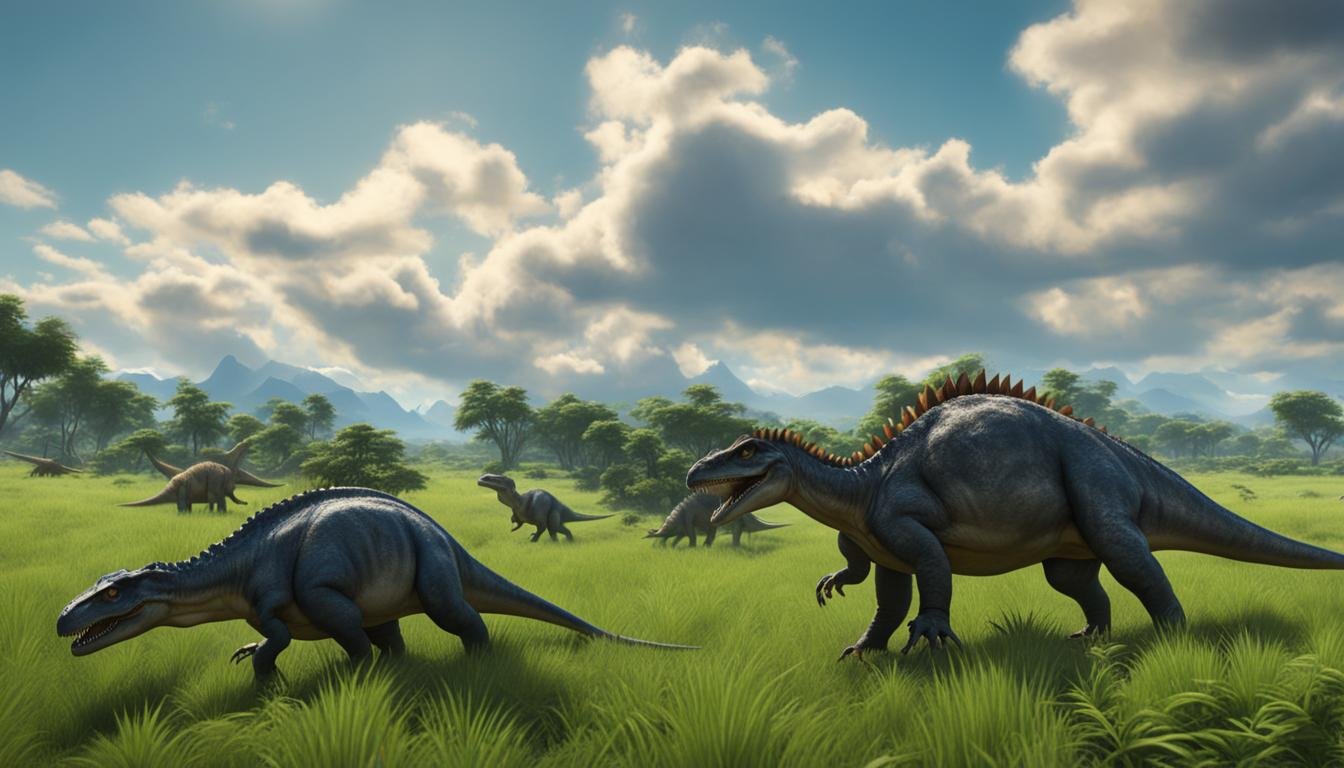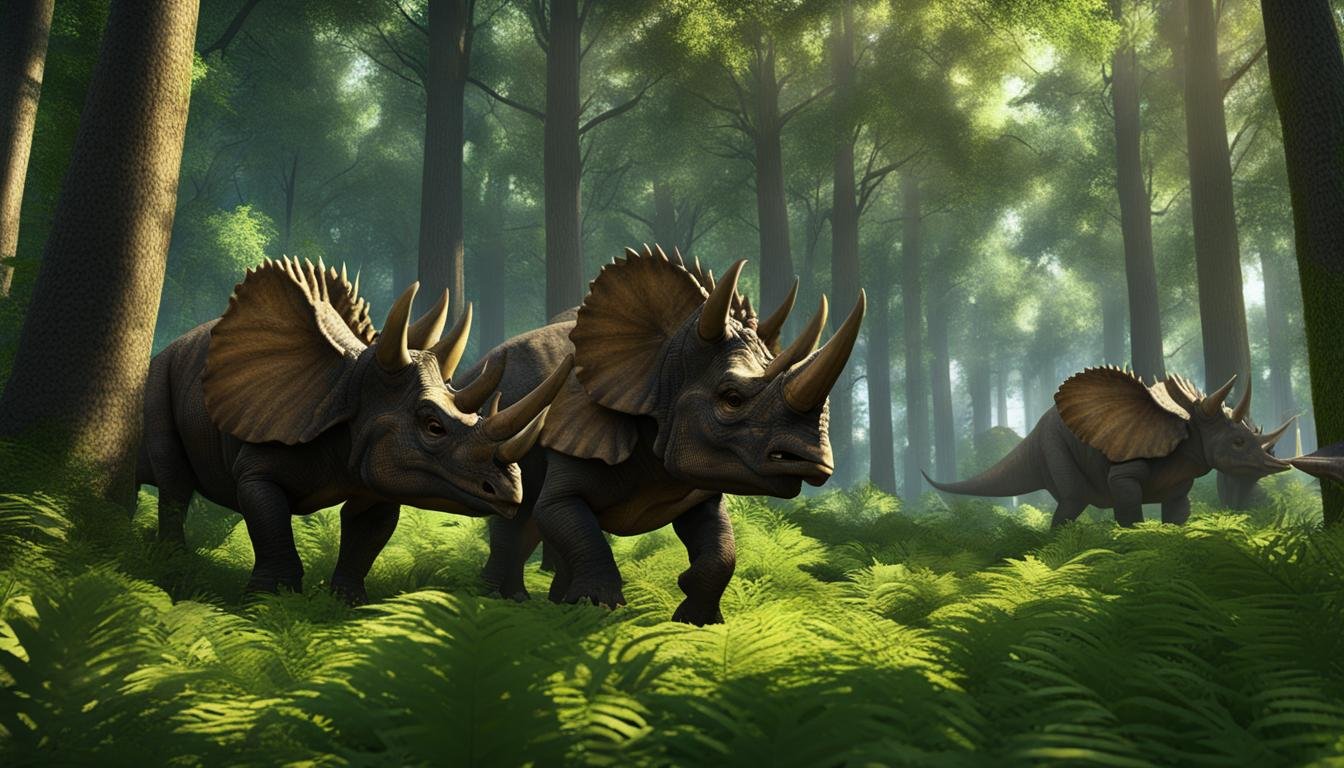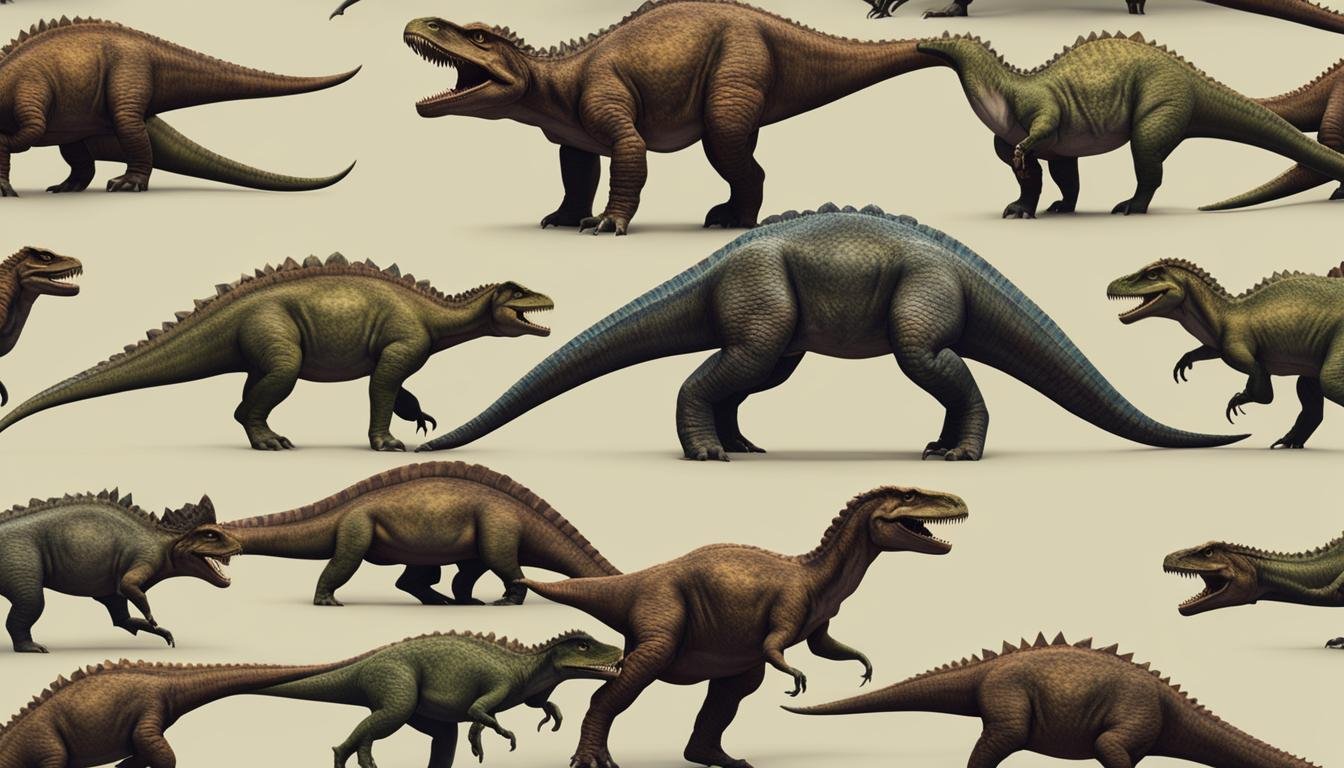The world of dinosaurs has always ignited our imagination, and we continue to uncover new insights into these fascinating creatures. One area of particular interest is their interspecies interactions and symbiotic relationships. While the fossil record does not provide clear evidence of mutualistic symbiosis between dinosaurs and other species, modern-day examples suggest that these interactions were likely present.
Through the study of fossil evidence and paleobiological studies, scientists have been able to piece together the puzzle of prehistoric mutualism. By analyzing ecological synergy and the dynamics of ancient ecosystems, we can gain a deeper understanding of the intricacies of dinosaur interspecies interactions.
| Key Takeaway | Detail |
|---|---|
| Prehistoric Mutualism | Dinosaur interspecies interactions and symbiotic relationships provide insights into prehistoric mutualism. |
| Fossil Record Limitations | The fossil record lacks clear evidence of mutualistic symbiosis among dinosaurs, though modern-day examples suggest its likelihood. |
| Complexities of Prehistoric Mutualism | Fossil evidence and paleobiological studies are key to understanding the complexities of mutualism in prehistoric times. |
| Contribution to Ancient Ecosystems | Studying dinosaur interspecies interactions enhances our understanding of ancient ecosystems. |
| Role of Ecological Synergy | Ecological synergy was a significant factor in the development of mutualistic relationships in prehistoric environments. |
The Complexity of Symbiotic Relationships
Symbiotic relationships in nature can be incredibly complex, with a wide range of interactions between different species. These relationships can be categorized into various types, each with its own unique dynamics and outcomes. To fully grasp the intricacies of symbiotic relationships, it is essential to understand the different types of interactions that can occur.
One common type of symbiotic relationship is commensalism, where one species benefits while the other remains unaffected. For example, certain bird species may build their nests in the trees, using the branches for support and protection, while the trees remain unharmed. This type of interaction highlights the importance of behavioral ecology, as the behavior and actions of one species can have a direct impact on the other.
On the other end of the spectrum, parasitism involves one species benefiting at the expense of the other. Parasites rely on their host for survival, often causing harm or distress. This type of relationship is driven by competitive exclusion, as parasites compete with their hosts for resources and space. Survival strategies play a crucial role in these interactions, as hosts may develop defenses to combat parasites, while parasites may evolve mechanisms to better exploit their hosts.
In the world of symbiotic relationships, competitive exclusion, cooperative hunting, resource sharing, territorial disputes, and survival strategies all come into play. These factors shape the dynamics between species and influence the outcomes of their interactions.
Cooperative hunting is another fascinating form of symbiotic relationship, where different species work together to secure food. An example of this is the cooperative hunting behavior between dolphins and certain species of birds. Dolphins herd fish into tight groups near the water’s surface, making it easier for the birds to catch their prey. This type of interaction highlights resource sharing and the benefits that can come from collaboration.
| Symbiotic Relationship | Key Factors |
|---|---|
| Commensalism | Behavioral Ecology |
| Parasitism | Survival Strategies |
| Cooperative Hunting | Resource Sharing |
| Territorial Disputes | Competitive Exclusion |
Territorial disputes are another factor that can influence symbiotic relationships. When two species have overlapping territories, conflicts can arise as they compete for limited resources and space. These disputes are driven by competitive exclusion and the need to establish dominance and ensure survival.
The complexity of symbiotic relationships arises from the interplay of various factors, including behavioral ecology, competitive exclusion, cooperative hunting, resource sharing, territorial disputes, and survival strategies. By understanding these different types of interactions, scientists can gain insights into the intricate web of relationships that exist within ecosystems and how they shape the dynamics of the natural world.
Examples of Mutualistic Symbiotic Relationships in Nature and Prehistoric Times
Symbiotic relationships are a fascinating aspect of the natural world, showcasing the interconnectedness and interdependence of different species. These relationships can be observed in various ecosystems today, as well as in prehistoric times. Let’s explore some examples of mutualistic symbiotic relationships and the intriguing dynamics they entail.
Gobies and Pistol Shrimps: A Perfect Team
The close association between gobies and pistol shrimps is a remarkable example of mutualism. Gobies, small fish known for their poor eyesight, rely on pistol shrimps to dig and maintain burrows for shelter. In return, gobies provide a valuable service by acting as sentinels, alerting the shrimps of potential danger. This cooperative relationship allows both species to thrive, with the gobies finding protection and the pistol shrimps benefiting from improved detection of predators.
Aphids and Ants: A Sweet Partnership
The relationship between aphids and ants highlights the benefits of mutualistic interactions in the context of food acquisition. Aphids, small sap-sucking insects, produce a sweet substance known as honeydew. Ants, in turn, are attracted to this sugary treat and protect aphids from predators, parasites, and even other aphids. In exchange, ants receive a nutritious food source. This symbiotic partnership between aphids and ants demonstrates how species can coexist and support each other’s survival through resource sharing and protection.
Clownfish and Anemones: A Safe Haven
One of the most well-known examples of mutualistic symbiosis can be found in the relationship between clownfish and anemones. Clownfish seek refuge among the venomous tentacles of anemones, which provide protection from predators. In return, clownfish clean and maintain the anemones by removing parasites and providing nutrients through their waste. This mutually beneficial relationship showcases the intricate balance of coexistence between species and the crucial role of habitat sharing.
| Species | Benefits |
|---|---|
| Gobies and Pistol Shrimps | Gobies receive shelter and protection, while pistol shrimps gain early warning of potential danger. |
| Aphids and Ants | Aphids receive protection and defense from predators, while ants obtain a valuable food source. |
| Clownfish and Anemones | Clownfish find protection from predators, and anemones benefit from cleaning services and nutrient exchange. |
These examples illustrate the complexity and diversity of mutualistic symbiotic relationships in nature. Through species coexistence, social dynamics, food web connections, ecological niches, interspecies communication, altruistic behavior, habitat sharing, and niche partitioning, organisms have forged partnerships that have shaped ecosystems throughout history. By examining fossilized trackways and studying adaptive behaviors, scientists can gain valuable insights into the ancient interactions between species and how they contributed to the intricate web of prehistoric mutualism.
The Role of Symbiosis in Ecosystem Balance and Environmental Impact
Symbiotic relationships play a crucial role in maintaining the balance of ecosystems and influencing the environmental impact of species. These relationships, including trophic interactions, defense alliances, and the interconnectedness of species within an ecosystem, contribute to the overall stability and functioning of the environment.
Trophic interactions, which refer to the transfer of energy and nutrients between different organisms in a food web, are a fundamental aspect of symbiotic relationships. Predatory-prey interactions, herbivore-plant relationships, and scavenger-decomposer dynamics all contribute to the flow of energy and nutrients within an ecosystem. Through these interactions, species maintain a delicate balance that ensures the sustainability of the overall system.
Defense alliances also play a significant role in ecosystem balance. Many species form partnerships to protect themselves from predators or to share resources more efficiently. For example, certain ants form symbiotic relationships with plants, defending them from herbivores in exchange for food and shelter. These defense alliances not only benefit the species directly involved but also contribute to the stability and functioning of the entire ecosystem.
Ecosystem balance is essential for the long-term survival of species and the overall health of the environment. The interconnectedness and interdependence of different species within an ecosystem create a delicate web of relationships that, when disrupted, can have far-reaching consequences. Understanding the role of symbiotic relationships in maintaining this balance is crucial for assessing the environmental impact of species and implementing effective conservation strategies.
The Importance of Trophic Interactions
Trophic interactions play a vital role in shaping the structure and function of ecosystems. These interactions determine the flow of energy and matter through the food web and influence the distribution and abundance of species within a community. Predation, herbivory, and decomposition are key trophic interactions that drive ecosystem dynamics.
Predation acts as a regulatory force in controlling prey populations, preventing overgrowth that could lead to resource depletion or ecological imbalance. Herbivory, on the other hand, shapes plant communities by influencing the abundance and distribution of different plant species. Decomposition is a critical trophic interaction that breaks down organic matter and recycles nutrients back into the ecosystem.
By understanding the intricacies of trophic interactions, researchers can better comprehend the ecological consequences of species interactions and how they contribute to ecosystem balance. This knowledge is crucial for implementing effective conservation strategies and managing the environmental impact of human activities on natural ecosystems.
The Significance of Defense Alliances
Defense alliances between species play a vital role in maintaining the overall balance of ecosystems. These alliances involve mutually beneficial interactions where one species provides protection or resources to another in exchange for specific benefits.
One example of a defense alliance is the relationship between cleaner fish and larger predatory fish. The cleaner fish remove parasites and dead skin from the predatory fish, benefiting from a food source while providing a cleaning service to their larger counterparts. This symbiotic relationship not only benefits both species involved but also contributes to the overall health and balance of the ecosystem.
Similarly, some plants form mutualistic relationships with ants, receiving protection from herbivores in exchange for food and shelter. These defense alliances promote biodiversity and enhance the resilience of ecosystems by reducing the impact of herbivory on plant populations.
Interconnectedness and Ecosystem Balance
The interconnectedness of species within an ecosystem is a fundamental aspect of maintaining balance and ecological stability. Each species occupies a unique ecological niche, and their interactions shape the structure and functioning of the entire community.
- Species A: Provides food and shelter to species B
- Species B: Pollinates flowers of species C
- Species C: Controls population of species D through predation
- Species D: Decomposes dead organic matter, releasing nutrients back into the ecosystem
This interconnectedness creates a delicate balance that ensures the sustainability of the ecosystem. The loss or disruption of one species can have cascading effects on other species and the overall functioning of the system. Understanding the role of symbiotic relationships in maintaining this interconnectedness is crucial for preserving biodiversity and promoting the long-term health of ecosystems.
| Trophic Interactions | Defense Alliances | Ecosystem Balance |
|---|---|---|
| Transfer of energy and nutrients through a food web | Mutually beneficial relationships for protection and resource sharing | Maintains stability and functioning of ecosystems |
| Regulates population growth and prevents resource depletion | Reduces predation or herbivory impact on species | Promotes biodiversity and resilience |
| Key drivers of ecosystem dynamics | Enhances the overall health and balance of ecosystems | Preserves biodiversity and ecological sustainability |
Uncovering Symbiotic Relationships Through Fossil Evidence and Paleobiological Studies
The study of fossil evidence and paleobiological studies provides us with valuable insights into the fascinating world of prehistoric symbiotic relationships. By examining paleontological records and coevolutionary patterns, scientists can uncover evidence of long-term interactions between species, shedding light on the complexities of ancient ecosystems.
Fossil evidence offers a unique glimpse into the past, allowing us to understand how organisms interacted and coexisted millions of years ago. Through meticulous examination of fossilized remains, researchers can identify signs of ecological synergy, where species rely on one another for survival. For example, the discovery of fossilized pollen on the bodies of prehistoric insects suggests a mutualistic relationship, where the insects acted as pollinators for plants, benefiting both parties.

Paleobiological studies go beyond the fossil record by exploring the ecological dynamics of ancient ecosystems. By reconstructing food webs and analyzing the distribution of species within a habitat, researchers can uncover clues about the interconnectedness and interdependence of prehistoric organisms. This helps us understand the role of symbiotic relationships in maintaining ecosystem balance and functioning.
| Paleontological Records | Coevolutionary Patterns | Long-Term Interactions |
|---|---|---|
| Paleontological records provide direct evidence of past life, revealing the presence of various organisms and their interactions. | Coevolutionary patterns highlight the reciprocal adaptations that occur between species over time. | Long-term interactions between species shape their evolutionary trajectories and contribute to the overall dynamics of ecosystems. |
| Fossils offer glimpses into ancient behaviors, such as predator-prey interactions or symbiotic partnerships. | Coevolution occurs when species mutually influence each other’s adaptations through natural selection. | Long-term interactions can lead to the development of specialized structures or behaviors that enhance survival. |
| By studying fossils, scientists can piece together the puzzle of past ecosystems and understand the roles different species played. | Coevolutionary patterns provide evidence of the interconnectedness of species and their reliance on one another. | Long-term interactions between species contribute to the stability and resilience of ecosystems over time. |
Through the combined efforts of paleontologists, ecologists, and evolutionary biologists, we can continue to unlock the secrets of prehistoric symbiotic relationships. The study of fossil evidence and paleobiological studies allows us to better understand the intricacies of ancient ecosystems, revealing the importance of ecological synergy and long-term interactions in shaping the natural world.
The Implications of Dinosaur Interspecies Interactions and Symbiotic Relationships
Understanding dinosaur interspecies interactions and symbiotic relationships has significant implications for our understanding of ancient biodiversity and ecosystem functioning. These relationships played a crucial role in shaping prehistoric ecosystems and influencing the evolution of adaptations and survival strategies in various species.
The impact on biodiversity was profound, as these interactions influenced the distribution of species and the overall composition of ancient ecosystems. Different species relied on each other for resources and protection, creating a delicate balance that allowed for the coexistence and persistence of diverse life forms.
Ecosystem functioning was also influenced by these symbiotic relationships. By cooperating or competing with each other, species contributed to the overall energy flow, nutrient cycling, and trophic dynamics within prehistoric ecosystems. This intricate web of interactions shaped the stability and resilience of these ancient habitats.
| Symbiotic Relationship | Impact on Biodiversity | Ecosystem Functioning |
|---|---|---|
| Plant-pollinator interactions | Facilitated the diversification of flowering plants and pollinators | Aided in the reproduction and dispersal of plant species |
| Herbivore-plant interactions | Shaped the distribution and abundance of plant species | Affected nutrient cycling and vegetation structure |
| Predator-prey interactions | Influenced the evolutionary arms race between predators and prey | Regulated population sizes and controlled herbivory |
Unraveling the complexities of these ancient symbiotic relationships provides valuable insights into the functioning of prehistoric ecosystems and the interconnectedness of species. It allows us to better understand the intricate mechanisms that governed the balance and stability of these ancient habitats, providing a foundation for studying modern ecosystems and their conservation.
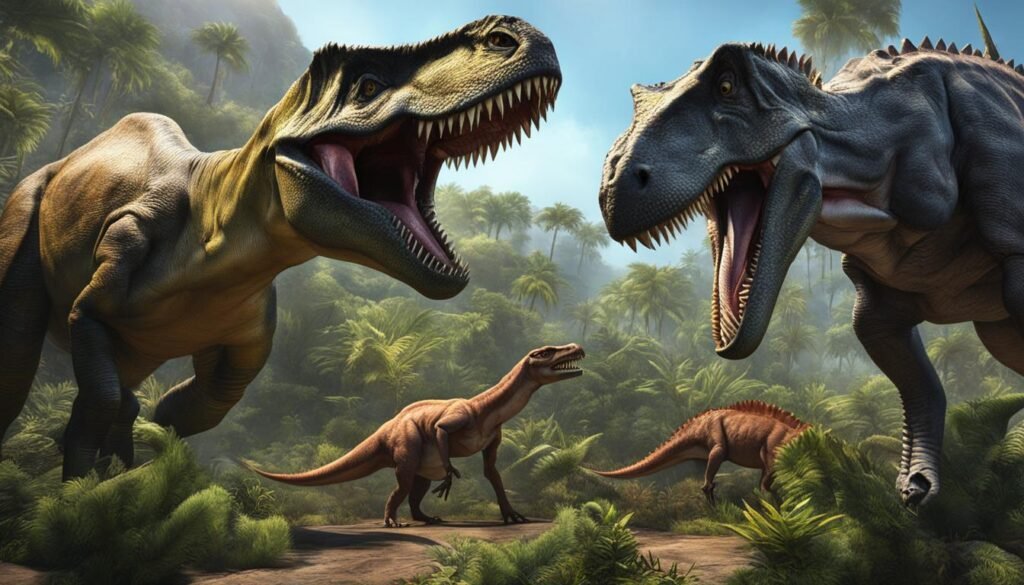
In conclusion, the study of dinosaur interspecies interactions and symbiotic relationships sheds light on the impact on biodiversity, ecosystem functioning, and the dynamic nature of prehistoric ecosystems. It highlights the importance of understanding the intricacies of ancient symbiotic relationships in our broader understanding of the natural world and the interdependence of species.
Conclusion
Dinosaur interspecies interactions and symbiotic relationships provide a fascinating window into the world of prehistoric mutualism. While the fossil evidence may not offer definitive proof, studying modern-day examples of symbiotic relationships offers valuable insights into the potential nature of these interactions in the past.
By understanding the role of symbiotic relationships in ancient ecosystems, we gain a broader understanding of biodiversity, ecological synergy, and ecosystem balance both in prehistoric and modern times. Although direct evidence of mutualistic symbiosis between dinosaurs and other species is scarce in the fossil record, the study of modern-day examples allows us to speculate on potential interactions between dinosaurs and their descendants, such as birds.
Exploring the complexities of symbiotic relationships sheds light on the intricate web of connections that existed in prehistoric ecosystems. These relationships impacted the evolution of adaptations and survival strategies in ancient species, shaping the dynamics of prehistoric ecosystems and their functioning. By unraveling the mysteries of prehistoric mutualism, we gain a deeper appreciation for the interdependent nature of life on Earth.

